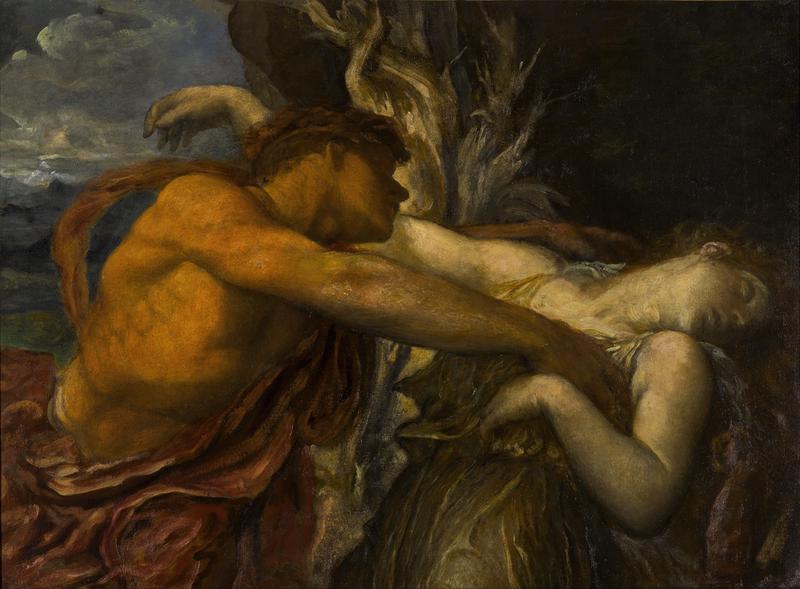Orpheus and Eurydice

Recently Exhibited
Mitsubishi Ichigokan Museum, Tokyo, Japan, Parabola of Pre-Raphaelitism – Turner, Ruskin, Rossetti, Burne-Jones and Morris, March to June 2019Kurume City Art Museum, Japan, Parabola of Pre-Raphaelitism – Turner, Ruskin, Rossetti, Burne-Jones and Morris, June to September 2019
Abeno Harukas Art Museum, Osaka, Japan, Parabola of Pre-Raphaelitism – Turner, Ruskin, Rossetti, Burne-Jones and Morris, October to December 201.
Additional Exhibition History
London, Peter Nahum, Burne-Jones, the Pre-Raphaelites and their Century, 1989, no.117Exhibition Archive
‘And now they were not far from the verge of the upper earth. He, enamoured, fearing lest she should flag and impatient to behold her, turned his eyes; and immediately she sank back again. She, hapless one! both stretching out her arms and struggling to be grasped and to grasp him, caught nothing but the fleeting air. And now, dying a second time, she did not at all complain of her husband; for why should she complain of being beloved?' (Ovid, Metamorphoses, translated by Riley, 1861).
When the wood-nymph Eurydice was fatally bitten by a snake, her husband Orpheus, son of the Sun-god Apollo and the Muse Calliope, refused to accept her death and journeyed from his home in Thrace to the Underworld to regain her. After charming the deities Pluto and Proserpine with his beautiful music which had the power to tame wild beasts, Orpheus was permitted to lead Eurydice through the shadows back to the Earth. He was warned that he must not look back at her until they were in the daylight again. At the moment that they were about to emerge from Hades, Orpheus was consumed with temptation to see his wife and turned to see her disappear back into the darkness, losing her again and forever. This moment is depicted in Watts dramatic painting: ‘He clasps her breast, she falls away, her arms lose their grip, her flesh pales, her head becomes limp, and she slips back into oblivion. Her transparent mouvementé drapery contrasting with his vigorous, ruddy body, heightens the sense of desire and the impotence of love in the face of death’ (Veronica Franklin Gould, G.F. Watts – The Last Great Victorian, 2004, p.89).
Orpheus and Eurydice is among Watts’s greatest compositions and has become famous through prints and the various versions that he painted. It is a tour de force of dramatic Symbolism and romantic power and one that embodies the vitality of the artist’s best work. He first painted the story of Orpheus and Eurydice in the late 1860s at a time of revival for classical subject matter in British art. The legend of Orpheus and Eurydice was one depicted by Sir Edward Poynter, Spencer Stanhope, Dante Gabriel Rossetti, Sir Edward Burne-Jones and by Watts’s neighbour, Sir Frederic Leighton, whose struggling lovers in his painting of 1864 (Leighton House, London) may have inspired Watts. Whilst Leighton’s painting has an odd staged melodrama, Watts’ ethereal and powerful painting style lent itself convincingly to this dynamic subject. Leighton’s musician appears to be pushing Eurydice away as she, not-understanding, tries to force him to look at her, but in Watts’s picture he is hopelessly trying to hold her as she slips away from him and he is compelled, by forces beyond his control, to look at her. A significant tenet of the new Classicism that emerged in the 1860s was that narrative should be conveyed by the artistic qualities of gesture, form and colour rather than in details and accessories that require reading and interpretation. Another important element of this new aesthetic was the connection between pictorial art and music, and the legend of Orpheus who restored the life of his beloved through the beauty of his lyre-playing, was central to this new art theory.
Watts was fascinated by the subject of Orpheus and Eurydice and made at least eight paintings of the two lovers. The earliest version is probably a less finished picture made in 1869 (Walker Art Gallery, Liverpool), there is an unfinished later version (Fogg Art Museum, Cambridge, Massachusetts) and a small variant was exhibited in the 1869 summer exhibition of the Royal Academy (Private collection). The present large version is probably the culmination of Watts’s experiments with a horizontal format and half-length figures, painted c.1870. Subtle refinements to the poses of the figures, particularly that of Orpheus, have enhanced their power and expressiveness. He is clothed in a swirling vortex of fiery red drapery, suggestive of the flames of his father Apollo the Sun-God. His tanned muscular body, indicative of his earth-bound dynamism contrasts with the languid pallor of Eurydice as she emerges from the Underworld where the sun does not reach. Watts omitted the lyre, which created an awkward element in the 1869 exhibited work and inserted the dynamic element of the dead tree-trunk marking the boundary between the worlds of life and death and alluding to Eurydice being a dryad. After 1872, the versions of Orpheus and Eurydice used a vertical format of full-length figures and arguably the intimacy and power of the composition was lessened. These full-length compositions (Aberdeen Art Gallery and another at the Watts Gallery, Compton) culminated in the large painting exhibited at the Grosvenor Gallery in 1878 (Salar Jung Art Gallery, Hyderabad, India). Watts never ceased to be fascinated by the subject and in the last years of his life he painted another version (Watts Gallery).
It is tempting to speculate whether the early Orpheus and Eurydice pictures were partly inspired by Watts’s emotions following the breakdown of his first marriage to the young actress Ellen Terry which resulted in separation after only eleven months in 1865. In the 1860s Watts became fascinated by themes of abandonment, romantic disappointment and separation, such as the legends of Ariadne and Clytie. Later in his life, Orpheus and Eurydice represented the opposite notions of fidelity, desire and eternal love and it is significant that the version now in Massachusetts was given by Watts to his second wife Mary as a wedding gift in 1886: ‘So sensual is the picture that Mary did not refer to the gift in her memoir of Watts’ (ibid., Gould, p.203). The present version remained in the artist’s possession until his death when it was inherited by Watts’s adopted daughter Lilian.
The model for Eurydice was Watts’s life-long friend Madeline Wyndham (1835-1920), who had posed for the voluptuous full-length Aesthetic Movement portrait in May 1867 (private collection). She was thirty-four, gloriously beautiful, charming and brimming with vitality: ‘She inherited the mysterious beauty of her grandmother Pamela Fitzgerald, wife of the Irish revolutionary Lord Edward Fitzgerald. She also carried the French blood of her other grandparents, Louis Philippe ‘Egatité’ Duc d’Orleans and his mistress, the educationalist Madame de Genlis, and she had the ‘wide minded’ indulgence of her Scottish father Sir Guy Campbell’ (ibid., Gould, p.87). With her handsome husband the Hon. Percy Wyndham, she was a member of the social set known as ‘The Souls’. Madeline was clearly delighted with her depiction as the nymph and purchased the version exhibited at the Royal Academy for the large sum of 200 guineas. This disappointed the Prime Minister William Gladstone who had hoped to be able to buy the painting himself from the Academy Private View.
Orpheus and Eurydice demonstrates the stylistic preoccupations of the new art movement of the 1860s, which believed that fifth century Greek art was the fountainhead of beauty. Phidias’s sculptures for the Parthenon (the Elgin Marbles) were regarded as the most important treasures of the ancient world, combining grandeur and naturalism. The figures in Orpheus and Eurydice reveal close study of the Parthenon pediment figures in their drapery and anatomy.
Such an important picture in Watts' oeuvre, Orpheus and Eurydice required a large number of sketches and drawings, mostly dating to the late 1860s (examples in the collection of drawings at the Royal Academy, Hammersmith & Fulham’s collection and in various private collections). There are also plaster casts from clay or wax originals in the Watts Gallery. The studies and the finished paintings reveal Watts’s fascination with dynamic controposto and especially with the stretch and turn of the necks which is present in many other works of this time (such as Clytie). This reflects Watts’s enthusiasm for the Renaissance artist that earned him the epithet of ‘England’s Michelangelo.’ Whilst aspects of Orpheus and Eurydice echo the traditions of the Renaissance, particularly the colouring of Titian, others are wholly modern and anticipate the abstractions of the next century.
Watts was a towering figure of the nineteenth century. He is perhaps now best-known for his magnificent sculpture Physical Energy in Kensington Gardens and for the large, imposing Mythological, Biblical and Symbolist canvases, such as Time, Death and Judgement 1868-84 (St Paul’s Cathedral), Hope of 1885 (private collection) and The Dweller in the Innermost of 1886 (Tate). His landscapes are powerful and beautiful with an almost ethereal quality and he also portrayed almost every great statesman, artist, poet, aristocrat and society beauty of his generation. He was genuinely interested in the great issues of the day and in his allegories he challenged the injustices of the world, child exploitation in The Minotaur of 1885 (Tate), the mass killing of birds for the fashion-trade in A Dedication of 1898 (Watts Gallery), the plight of the poor and mistreated in Found Drowned c.1850 (Watts Gallery), The Irish Famine of 1848-50 (Watts Gallery) and Death Crowning Innocence of 1886-93 (private collection). The most famous of all his paintings is Hope, a postcard of which Nelson Mandela kept in his prison-cell at Robin Island. This is a painting that has inspired countless people, including Martin Luther King who referred to it in a speech and Barack Obama. Another famous picture by Watts, Love and Life (private collection) hung for many years at the White House in Washington whilst Watts’s murals for the Palace of Westminster are testament to the glory of nineteenth century Britain.



